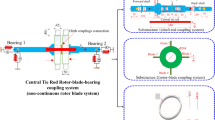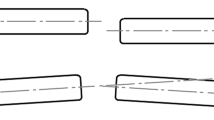The contact pressure distribution of the curvic couplings in a heavy duty gas turbine under a blade-off load condition is investigated in a three-dimensional finite element model. Several blade-off positions on each stage disk may develop the different characters on the contact pressure distributions of the curvic couplings during the application of a blade-off load. Both the position and magnitude of the applied blade-off load and the distribution of the spindle bolts have an effect on the contact pressure distribution of the curvic couplings. Further the contact stress on the left and right sides of the teeth develops different characters during the application of torque load following not only a normal centrifugal load but also a blade-off load which produces a unbalanced equivalent bending force. Furthermore the stiffness of the connection body part of the rotor between the compressor end and the turbine end associated with its section thickness is crucial in deciding the contact stress distribution on the curvic couplings. This analysis shows a change in the magnitude of contact stress of each set of the curvic couplings.








Similar content being viewed by others
References
I. J. Richardson, T. M. Hyde, A. A. Becker, and J. W. Taylor, “A three-dimensional finite element investigation of the bolt stresses in an aero-engine curvic coupling under a blade release condition,” in: Proc. of the Institution of Mechanical Engineers, Part G: J. Aerospace Eng., 214, 231–245 (2000).
Y. Zeyong, H. Baian, W. Jianguo, et al., “Calculation of axial relaxed/pressed forces of rotors with curvic couplings,” Acta Aeronaut. Astronaut. Sin., 5, Q16 (1996).
H. Baian, Y. Zeyong, and X. Youliang, “Determination of axial preloads of rotor with curvic couplings pretightened into two segments,” J. Mech. Strength, 21, No. 4, 274–277 (1999).
N. L. Pedersen and P. Pedersen, “Stiffness analysis and improvement of bolt-plate contact assemblies,” Mech. Based Des. Struct. Mach., 36, No. 1, 47–66 (2008).
S. R. Pisani and J. J. Rencis, “Investigating curvic coupling behaviour by utilizing the two and three dimensional boundary and finite element methods,” in: Int. Conf. on Boundary Element Methods, XV: Fluid Flow and Computational Aspects (Aug. 10–13, 1993), pp. 597–608 (Computational Mechanics).
I. J. Richardson, T. H. Hyde, A. A. Becker, and J. W. Taylor, “A validation of the three-dimensional finite element contact method for use with curvic couplings by comparing predictions with photoelastic test data,” in: Coupling and Shaft Technology for Aerospace Transmissions Seminar (June 9, 1999, Solihull) (Lucas Electrical and Electric Systems).
S.-X. Yuan, Y.-Y. Zhang, Y.-C. Zhang, and X.-J. Jiang, “Stress distribution and contact status analysis of a bolted rotor with curvic couplings,” in: Proc. of the Institution of Mechanical Engineers, Part C: J. Mech. Eng. Sci., 224, 1815–1829 (2010).
ANSYS User’s Manual Revision 8.0, ANSYS Inc., Canonsburg, PA (2004).
Acknowledgment
We would like to express our thanks to the financial support of this work by the National Basic Research Program of China (Grant No. 2011CB706601).
Author information
Authors and Affiliations
Additional information
Translated from Problemy Prochnosti, No. 5, pp. 105 – 119, September – October, 2012.
Rights and permissions
About this article
Cite this article
Jiang, XJ., Zhang, YY. & Yuan, SX. Analysis of the contact stresses in curvic couplings of gas turbine in a blade-off event. Strength Mater 44, 539–550 (2012). https://doi.org/10.1007/s11223-012-9412-3
Received:
Published:
Issue Date:
DOI: https://doi.org/10.1007/s11223-012-9412-3




